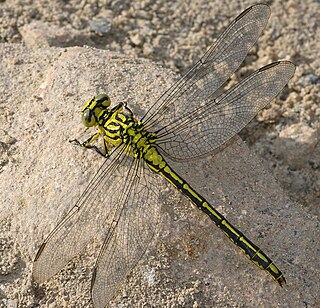
The lesser yellowlegs is a medium-sized shorebird. The genus name Tringa is the New Latin name given to the green sandpiper by Aldrovandus in 1599 based on Ancient Greek trungas, a thrush-sized, white-rumped, tail-bobbing wading bird mentioned by Aristotle. The specific flavipes is from Latin flavus, "yellow", and pes, "foot".

The yellow-footed antechinus, also known as the mardo, is a shrew-like marsupial found in Australia. One notable feature of the species is its sexual behavior. The male yellow-footed antechinus engages in such frenzied mating that its immune system becomes compromised, resulting in stress related death before it is one year old.

Reticulitermes flavipes, the eastern subterranean termite is the most common termite found in North America. These termites are the most economically important wood destroying insects in the United States and are classified as pests. They feed on cellulose material such as the structural wood in buildings, wooden fixtures, paper, books, and cotton. A mature colony can range from 20,000 workers to as high as 5 million workers and the primary queen of the colony lays 5,000 to 10,000 eggs per day to add to this total.
The yellow-legged weaver is a species of bird in the Ploceidae family. It is endemic to Democratic Republic of the Congo.

The river clubtail or yellow-legged dragonfly is a species of dragonfly in the family Gomphidae. It is found in Europe. Its natural habitat are rivers and large streams. The dragonfly flies from June to September depending on the location.

Rhinotermitidae is a family of termites (Isoptera). They feed on wood and can cause extensive damage to buildings or other wooden structures. About 345 species are recognized, among these are severe pests such as Coptotermes formosanus, Coptotermes gestroi, and Reticulitermes flavipes.

Amanita flavella is a species of mycorrhizal fungus from family Amanitaceae that can be found in New South Wales and Queensland Australia. The species have a convex lemon-yellow coloured cap that is up to 90 millimetres (3.5 in) in diameter. They can also be yellowish-orange coloured and have crowded gills that are pale yellow in colour. The stipe is central and just like the cap is 90 millimetres (3.5 in) high and yellowish white in colour. It is slightly bulbous, and is enclosed into a volva. The ring is flared and white coloured. The ring is ample, membranous, and yellowish in colour. The spores are 8.5–10 µm long and 6–6.5 µm wide, and are white coloured, amyloid and ellipsoid. The species is similar in appearance to Amanita flavoconia and Amanita flavipes.
Nyctonympha is a genus of longhorn beetles of the subfamily Lamiinae, containing the following species:
Nyctonympha andersoni is a species of beetle in the family Cerambycidae. It was described by Martins and Galileo in 1992. It is known from Bolivia and Colombia.
Nyctonympha genieri is a species of beetle in the family Cerambycidae. It was described by Martins and Galileo in 1992. It is known from Ecuador.
Nyctonympha howdenarum is a species of beetle in the family Cerambycidae. It was described by Martins and Galileo in 1992. It is known from Colombia.
Nyctonympha taeniata is a species of beetle in the family Cerambycidae. It was described by Martins and Galileo in 1992. It is known from Panama and Trinidad and Tobago.
Nyctonympha affinis is a species of beetle in the family Cerambycidae. It was described by Martins and Galileo in 2008.
Nyctonympha annulata is a species of beetle in the family Cerambycidae. It was described by Per Olof Christopher Aurivillius in 1900. It is known from Panama and Venezuela.
Nyctonympha boyacana is a species of beetle in the family Cerambycidae. It was described by Galileo and Martins in 2008. It is known from Colombia.
Nyctonympha carcharias is a species of beetle in the family Cerambycidae. It was described by Lameere in 1893, originally under the genus Hebestola. It is known from Venezuela.
Nyctonympha carioca is a species of beetle in the family Cerambycidae. It was described by Galileo and Martins in 2001. It is known from Brazil.
Nyctonympha costipennis is a species of beetle in the family Cerambycidae. It was described by Lameere in 1893. It is known from Venezuela.
Nyctonympha cribrata is a species of beetle in the family Cerambycidae. It was described by Thomson in 1868. It is known from Colombia.
Nyctonympha punctata is a species of beetle in the family Cerambycidae. It was described by Martins and Galileo in 1989. It is known from Argentina.








